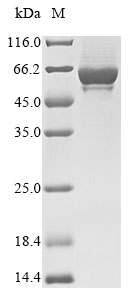Recombinant Human Toll-like receptor 4 (TLR4) is produced through a baculovirus expression system and spans amino acids 27 to 631, representing a partial protein length. The protein carries an N-terminal 6xHis tag and shows purity levels exceeding 85% when analyzed by SDS-PAGE. This preparation is intended solely for research purposes and may serve as a dependable tool across different experimental setups.
Toll-like receptor 4 (TLR4) appears to be a crucial player in the innate immune system, best known for its ability to recognize lipopolysaccharides from Gram-negative bacteria. As a transmembrane protein, it seems to help activate immune cell signaling cascades that trigger inflammatory responses. TLR4 has drawn considerable research interest because of its central role in innate immunity and its apparent involvement in numerous inflammatory conditions.
Potential Applications
Note: The applications listed below are based on what we know about this protein's biological functions, published research, and experience from experts in the field. However, we haven't fully tested all of these applications ourselves yet. We'd recommend running some preliminary tests first to make sure they work for your specific research goals.
Human TLR4 is a complex transmembrane pattern recognition receptor whose extracellular domain (27-631aa) requires precise folding, proper leucine-rich repeat (LRR) domain formation, and correct disulfide bonding for ligand recognition and co-receptor binding. The baculovirus-insect cell expression system provides a eukaryotic environment that supports proper protein folding, disulfide bond formation, and some glycosylation modifications. However, TLR4 functionality critically depends on its partnership with MD-2 and proper dimerization, which this partial extracellular domain fragment may not fully support. While the expression system increases folding probability, the absence of the transmembrane and intracellular domains, combined with the N-terminal 6xHis-tag potentially interfering with the N-terminal structural organization, necessitates experimental validation to confirm structural integrity and ligand-binding capability.
1. Protein-Protein Interaction Studies
This application carries significant limitations due to the complex nature of TLR4 interactions. Functional TLR4 requires MD-2 co-receptor association and proper dimerization for ligand binding. The extracellular domain fragment (27-631aa) lacks the transmembrane domain necessary for native conformational constraints, and the N-terminal His-tag may sterically interfere with the MD-2 binding site. Without validation of correct LRR domain folding and MD-2 binding capability, interaction studies may yield false negatives or identify non-physiological binding partners.
2. Antibody Development and Characterization
This application is highly suitable as antibody generation primarily depends on linear epitope availability rather than functional protein conformation. The extracellular domain fragment provides comprehensive antigenic coverage of the LRR regions, making it ideal for generating antibodies targeting the ligand-binding domain. The high purity (>85%) ensures minimal immune responses to contaminants, and the His-tag facilitates efficient purification during antibody production and screening processes.
3. Structural and Biophysical Analysis
These studies are essential priority applications for determining the folding quality and structural integrity of the protein itself, not the native TLR4. Techniques should include circular dichroism spectroscopy to assess secondary structure content of LRR domains, size-exclusion chromatography with multi-angle light scattering to evaluate oligomeric state, and thermal shift assays to determine stability. However, the tags may interfere with crystallization for high-resolution structural studies.
4. Pull-Down Assays and Co-Immunoprecipitation Studies
This application requires rigorous validation due to TLR4's dependency on co-receptors. The extracellular domain may not form proper complexes with MD-2, potentially leading to artifactual interactions. If correctly folded and validated for MD-2 binding (verified), it may be suitable for controlled interaction studies. If unverified, there is a high risk of identifying non-physiological binding partners that do not reflect native TLR4 signaling complexes.
Final Recommendation & Action Plan
The baculovirus-expressed TLR4 extracellular domain fragment is suitable for structural characterization and antibody development but has significant limitations for functional studies due to its partial nature and co-receptor dependency. Begin with Application 3 (Structural and Biophysical Analysis) to validate folding quality through CD spectroscopy, SEC-MALS, and MD-2 binding assays. Application 2 (Antibody Development) can proceed immediately. For Applications 1 and 4 (interaction studies), first confirm MD-2 binding capability and compare results with full-length TLR4 systems. Always include appropriate controls: validate key findings with full-length receptor systems, use known ligands as positive controls, and consider the fragment's limitations in data interpretation.






